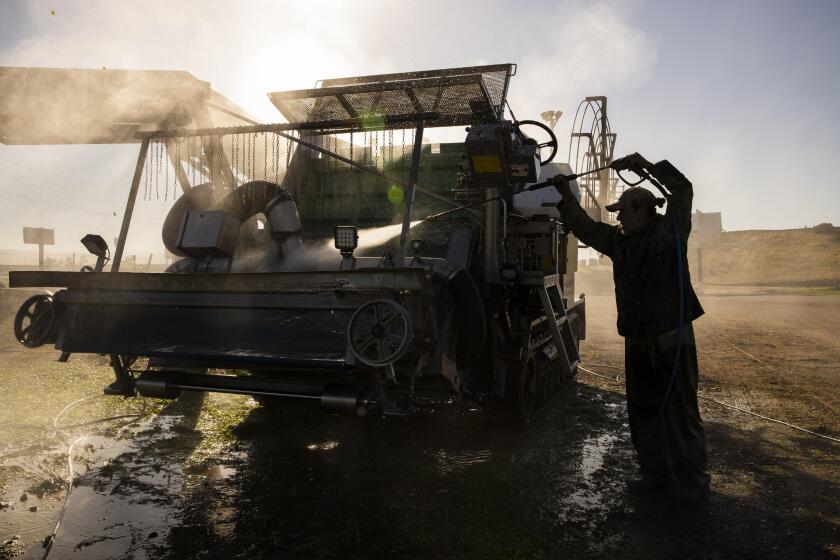Raging River Takes Toll on Camps, Bridges
When the rain stopped briefly and the sun lit the snow-capped peaks of the San Gabriel Mountains, Kermit Young propped his sprained left foot on a rampart of sandbags protecting his home from furious floodwaters.
“I’m going to have to put pontoons on my trailer next,” said the 55-year-old bear of a man, surveying the gray torrent of San Gabriel River’s east fork.
He sprained his ankle during last week’s stormy weather while building a dike at Camp Williams, a mobile home park and campground seven miles north of San Dimas.
Camp Williams and Follows Camp, another private campground resort a mile downstream, were among the San Gabriel Valley’s hardest-hit places and one of the rainiest spots in Los Angeles County during the last week. By Wednesday morning, the U.S. Forest Service had recorded close to 12 inches of rainfall in eight days near the camps.
Two bridges and scores of picnic tables were washed away, and dozens of acres of developed campsites were torn apart as the river overflowed its banks at both resorts.
Worried residents kept an eye on the river Wednesday as a new storm threatened more flooding. Normally 15 to 20 feet wide, the river was swollen to four times that size.
The series of storms this week dumped six inches of rain on San Gabriel communities from Wednesday to Tuesday, contributing to two serious injuries. The driver of a garbage truck Tuesday lost control on rain-slick Valley Boulevard in the City of Industry, rammed through a block wall and plowed through lemon trees at a residence.
The driver, 24-year-old Jorge Haro of El Monte, was listed Wednesday in serious condition at Los Angeles County-USC Medical Center. His cousin, 37-year-old Rosendo Haro of El Monte, was listed in critical condition at Queen of the Valley Hospital in West Covina.
Minor rain damage could be seen everywhere. Mud and rocks slid down mountains from Mt. Baldy to Mt. Wilson and more modest hillsides from Glendale to Hacienda Heights, blocking roadways such as California 39 north of Azusa, Turnbull Canyon Road in Hacienda Heights, and Mt. Baldy Road north of Claremont.
At San Gabriel Mountain ski resorts, rivers of rain ruptured the snowpack and in some cases momentarily washed away the snow. But by midweek, the snow was returning in full force. “It’s snowing flakes the size of silver dollars,” Ray Hensley at Kratka Ridge said Tuesday afternoon.
During the last week of storms, huge trees toppled in Arcadia and Hacienda Heights.
Digging out from the muddy morass in Hacienda Heights, an infuriated Marilyn Evans said the county must do more to get property owners to clean up brush that contributes to the fire-flood-erosion cycle that plagues the area.
“With each rainstorm, more of the land goes,” said Evans as she stood over a 10-foot-deep gash in the earth that floodwaters cut into the hilly upper end of her Hacienda Heights back yard.
Evans, a retired Temple City High School history teacher, and her husband, a Pomona businessman, have fought a losing battle with the county Public Works Department against the runoff around their home, on an acre near Turnbull Canyon Road. They have lived in the ranch-style house since the mid-1980s and are angry that county officials have not done more to solve the flooding problems in Hacienda Heights.
At her house and throughout her suburban neighborhood, rows of sandbags were stacked to prevent a further onslaught of water, mud and debris.
Besides the county, the Evanses blame the flooding on new housing developments in the surrounding hills that they say have altered the course of runoff and overwhelmed storm drains.
Except for Hacienda Heights and Malibu, the county’s intricate system of storm drains, flood control channels and reservoirs are handling the rains, flood control officials say.
In the San Gabriel Mountains, about seven miles north of San Dimas, Joe Davison on Monday squished his 1946 Jeep over muddy roads at Follows Camp and worried about how he was going to undertake an estimated $70,000 in repairs to the private campground he owns and manages.
Although surrounded by the Angeles National Forest, the 85-acre camp--like Camp Williams--is on private land that was the site of a 19th Century gold rush. A few structures remain from that era, and Follows Camp today is an enterprising collection of modest trailers, apartments and mountain houses set hard between the canyon wall and the winding river.
“There really isn’t anything you can do about this. You just wait, you hope and you pray,” Davison, 56, said during a lull in the storms as he watched a heavy-equipment operator shovel bucket-loads of debris from what was left of one of the bridges that were washed out.
Davison said the camps had survived a century’s worth of storms and would survive this one, too. “We’re just frustrated,” he said.
On a bicycle, Follows Camp resident Willy Whipp bumped across the area that once was the campground and recounted watching the storm waters last Thursday at close to midnight.
“It was spectacular,” said Whipp, 40, a commercial artist who lives in a 23-foot-trailer. He watched the floodwaters from the security of his screened-in porch. “I was just awe-struck.”
At Camp Williams the reaction to the sound and fury of the rushing water was similar.
“You try to tell people what the sound is like,” said Camp Williams manager Pat Burress, 54, as she stood along the river with Kermit Young.
“The water’s moving rocks that are the size of Volkswagens, and they are hitting together.”
She looked at a wall of sandbags that ringed the riverbank, which was awash in a thick layer of gray silt. Splintered alders littered the rocky ground, where recreation vehicles are normally parked. “This is all that’s left of a 92-site campground. We are definitely out of the camping business for a while.”
But Burress wouldn’t want to live anywhere, she said, other than her hilltop double-wide mobile home--with a safe view of the rushing waters cutting a new, more expansive riverbed.
More to Read
Start your day right
Sign up for Essential California for news, features and recommendations from the L.A. Times and beyond in your inbox six days a week.
You may occasionally receive promotional content from the Los Angeles Times.






